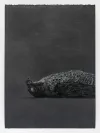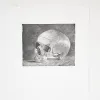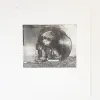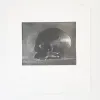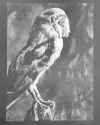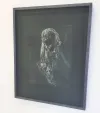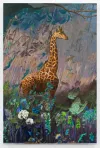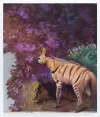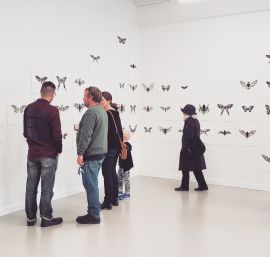JOHN PUSATERI
LAST NIGHTS DREAM
22 July – 10 August, 2018
Artist Talk: Saturday 28 July, 2pm
What do we do with last nights’ dreams? Did they arrive from nowhere? A random, fleeting sequence of details and images dredged from our subconscious? Or were they part of a vivid evolving narrative that remains with us throughout the day? Ephemeral and ambiguous, dreams slip by unnoticed unless we choose to record them. Like last nights’ dreams, transitory night-time visitors: owls, bats, or moths fluttering in a lamplight can appear unannounced, apparition-like. Suspended between night and day; the conscious and subconscious; or the artificial and natural worlds, a ‘dreamscape’ of memento mori is gathered in this exhibition. John’s monotype prints and stone lithographs create a shutter-like effect or a dreamlike sequence of apparitions of mysterious night-time visitors. Speaking to a delicate balance of natural phenomena and evolutionary processes, along with scientific practices of cataloguing, Last Nights’ Dreams invites us to contemplate notions of transience and fragility.
This collection is partly a reworking of established histories of museum cataloguing and dioramas. These histories were typically based on an extraction of species from natural ecosystems for study, preservation or display in artificial ‘curiosity cabinets.’ John’s printed impressions of catalogued birds, bats, butterflies, moths and insects held in museum collections highlight the disorientating and unnatural effect of encountering the natural by way of the artificial. His works can offer a conduit through which conversations about preservation, speciation, mortality, extinction and survival might take place.
The Past Visitant series depicts a commonly sighted species of barn owl from the United States. Drawn partly from an imported cultural mythology and partly from scientific studies of owls, this series also makes reference to the recent arrival of a breeding pair of barn owls in Aotearoa. Intruders from afar or masterful survivors, the owls’ arrival is phantom-like; they appeared seemingly from ‘nowhere’ without human intervention. In its natural environment, the bird’s feather structure assures silent flight, unseen by its prey. Today it has been forced into irregular migratory patterns, the result of human-made urban development, drifting here to settle into a new ecosystem and our collective awareness.
Eighty painterly monotypes of moths partly reflect the residual qualities of evolutionary process as these insects adapt to changing environmental conditions which threaten their existence. ‘Speciation,’ a term used to describe subtle variations in a species to ensure survival through hybridity, is captured in these prints which mirror this delicate evolution. Pigment is applied to the plate and modified subtly by the artist’s hand as a form takes shape; as each unique sequential image is created, the residue of the original layer remains. Conceptually, this process mimics the evolutionary processes and adaptability of natural species and ecosystems.
Similar to dreams, the imperceptible changes that occur in natural ecosystems appear transient and often resilient, yet they are also fragile. They disappear unless we create for them a narrative in our collective awareness. With reference to scientific practices of collecting, documenting and decontextualizing the natural order, Last Nights’ Dreams asks us to consider the struggle for natural species’ to survive and adapt in habitats increasingly modified through artificial development.
Elisha Masemann
Born in Pittsburgh, Pennsylvania, Pusateri lives in Auckland and works in a variety of mediums from photography, digital media and drawing to printmaking and painting. He graduated with a Bachelor of Fine Arts from Syracuse University, and a Master of Fine Arts (honours) from the University of Auckland.
Pusateri is the founder / director of Auckland Print Studio and a lecturer in Architecture at Unitec Institute of Technology. He has exhibited in the USA, Ireland, Italy, Canada, Costa Rica, England, Japan, Taiwan and New Zealand. His work has won awards and is represented in numerous private and public collections.

